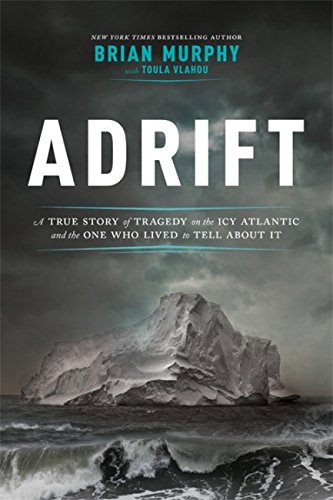“Adrift: A True Story of Tragedy in the Icy Atlantic and the One Who Lived to Tell About It.”
I have been researching, finding and salvaging historic shipwrecks for over fifty years, so I jumped at the chance to get an advance reading copy of New York Times bestselling author Brian Murphy’s soon to be released book Adrift: A True Story of Tragedy in the Icy Atlantic and the One Who Lived to Tell About It.
Not being familiar with Murphy’s work, I expected his book, which was written with the collaboration of his wife, Toula Vlanhou, to be limited to a dramatized account of seaman Thomas Nye’s efforts to survive as he watched the dozen men, women and children in the lifeboat with him die from thirst and the freezing cold of the North Atlantic after the square-rigged sailing packet John Rutledge was sunk by an iceberg on February 20, 1856. Of course, Murphy’s book turned out to be considerably more — it is extensively researched and likely the best book ever written explaining the decades lasting, interlacing effects of shipwrecks on families, businesses, and even global politics. Shipwrecks aren’t the isolated events that one might otherwise believe, they can impact society as a whole and the authors make that abundantly clear.
Besides a valuable cargo, the John Rutledge carried 123 passengers plus a large crew. Was her loss necessary or even unexpected? That question is raised because her captain, Alexander Kelly, refused to let his wife, Irene, who normally traveled with him, come on the voyage. Instead he left her in Liverpool, far from their home in America, promising to return in a few months. He and all but Thomas Nye perished. Did Captain Kelly have a premonition?
After Captain Kelly finally ordered his doomed ship to be abandoned, most of the people made it safely into the ship’s four lifeboats. But, before all could safely disembark, the strong current whisked all four lifeboats away from the still floating but rapidly sinking wreck. Nye’s lifeboat, with just 13 people in it, could have carried many more, but was quickly separated from the wreck and from the other lifeboats. Nye’s lifeboat had less than one day’s food and water.
Picked up the 10th day after the wreck, Nye was the sole survivor from the John Rutledge. Without Nye’s account, the families and friends of the other passengers and crew of the John Rutledge would never have known how their loved ones met their fate. He told of the striking of the iceberg, the heroic efforts to save the ship, its abandonment, the people left behind, and the struggle of the people aboard Nye’s boat against the freezing weather, gale force winds, and the ice floes and bergs, which could upend or crush the lifeboat, as well as the tormenting thirst made all the worse by the water that was everywhere. Nye wisely chose not to satiate his thirst with saltwater, but the others did and they all died, some in delirium and agony.
The John Rutledge was not the only vessel to sink in the North Atlantic during the first few months of 1856. There was also major loss of life on the steamer Pacific and the clipper ships Driver and Ocean Queen, which were all lost without a trace. Between just those four the death toll was nearly 830 passengers and crew. Add to that the dozens of lives lost on smaller vessels the list of dead approached one thousand. Worldwide, the shipping losses for the first six months of 1856 easily totaled over 300 and cost today’s equivalent of well over a half billion dollars.
The book Adrift is scheduled for release in September of 2018, and will soon be available through Amazon. I highly recommend it to both scholars and the general public alike. If there is a compassionate or empathetic bone in their body — all, who read Adrift, will shed tears for those who perished as their tragic story is brought to life by Brian Murphy.
Reviewed by Dr. E. Lee Spence, Underwater Archaeologist
President, Sea Research Society
